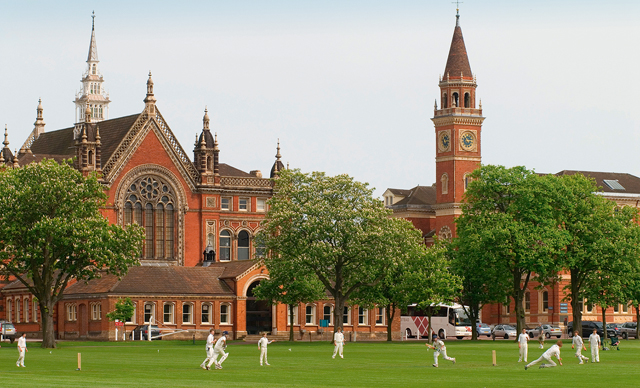London’s most genteel village
London's most genteel village is an elegant, green location where prices have quietly rocketed by nearly 900% in 20 years


South East London hasn’t always been an obvious stomping ground for successful families in search of a new house— except, that is, for a clever few. Statistics released last week by Knight Frank’s research department reveal that, while we’ve all been watching with awe (and horror) as house prices in the much-loved London neighbourhoods of Chelsea, Kensington and Fulham rise meteorically beyond the means of all but a very few, those in the south-east enclave of Dulwich haven’t been at a standstill.
‘Since the Land Registry began publishing house-price data 20 years ago, in January 1995, the records for houses in the SE21 postcode, that of Dulwich Village, have risen by a staggering 897%.
‘As international and domestic buyers have pushed central London prices skyward, families looking for more space and affordability have had to look beyond Zone 1,’ says Paul Humphreys, who heads up Knight Frank’s recently opened Dulwich office (020–3815 9410). ‘There hasn’t been a revolution—Dulwich is too genteel for that—but rather an evolution, which has put Dulwich and its surrounding areas on the map.’
The attractions of Dulwich are manifold: 42% of the housing stock pre-dates 1900 and much of it is preserved and managed under the watchful eye of the Dulwich Estate, the 400-year-old charity set up by the Elizabethan actor-turnedentrepreneur Edward Alleyn. Added to this, Dulwich Village itself is a conservation area.
‘Not unlike the Howard de Walden Estate’s approach to Marylebone and its high street, the Dulwich Estate has focused on conserving the village-like atmosphere by retaining the finger signposts, employing strict controls on its streetscapes and encouraging independent shops,’ explains Robin Chatwin, who heads up Savills’s southwest London office (020 –3430 6905).
It’s not true to say that Dulwich has undergone a gentrification over the past two decades, but the peripheral areas, such as East and West Dulwich, have seen a major uplift of interest with good rail links into either London Bridge or Victoria and, a little further afield, via the London Overground network. ‘Dulwich has long been a soughtafter area, particularly with families and young professionals who want the benefit of being close to the City, but in a place that has character and a community feel,’ believes Oliver Burgess of Winkworth’s local office (020– 8299 2722).
‘Unlike many neighbouring areas, such as Clapham and Balham, Dulwich tends to be somewhere that people end up settling,’ adds Mel Carter of Hamptons International Dulwich (020–3369 4375). ‘The village feel, together with the Dulwich Woods and Dulwich & Sydenham Hill Golf Club, allows residents to have the best of both worlds: a rural lifestyle with a London postcode.’
Sign up for the Country Life Newsletter
Exquisite houses, the beauty of Nature, and how to get the most from your life, straight to your inbox.
But the main draw for families is the trio of excellent private schools in the area. Alleyns, James Allen’s Girls (known locally as JAGS) and Dulwich College (which counts P. G. Wodehouse among its alumni) are all within walking distance of the village and are responsible for drawing buyers from far and wide — including Russia and China (Dulwich College has outposts in both China and Singapore). ‘We’ve got a Russian buyer looking here because their child is about to start at Dulwich College,’ explains Robin. ‘It’s an excellent choice for parents whose children have been educated in the local system and who don’t want to send their children away to board.’
Prices per square foot in Dulwich range between £600 and £1,100, according to Knight Frank’s figures, and the Winkworth office says you need to spend £700,000 for a two-bedroom flat. ‘If you’re looking for a family house in the village, they start at £1.75 million and rise up to £10 million, although we currently have three on the market for between £3.2 million and £3.75 million,’ adds Robin.
‘If you factor in all that’s happening in the wider area,’ enthuses Paul, ‘from the grocer in Peckham with eight different types of tomatoes and the trendy cafes and markets of East Dulwich, to the delights of the Dulwich Picture Gallery and the wide, green spaces that make you think you might be in the middle of Gloucestershire, it’s a whole ecosystem in one little area.’
Need to know: Dulwich delights Deli Romeo Jones (020–8299 1900) Butchers William Rose (020–8693 9191) and Flock & Herd (020–7635 7733) Cafe Brick House Bakery Bookshops Tales on Moon Lane (020–7274 5759) and Rye Books (020–3581 1850) Cinema East Dulwich Picture House Fishmonger Moxon’s (020–8299 1559)
-
 ‘It had the air of an ex-rental, and that’s putting it politely’: How an antique dealer transformed a run-down Georgian house in Chatham Dockyards
‘It had the air of an ex-rental, and that’s putting it politely’: How an antique dealer transformed a run-down Georgian house in Chatham DockyardsAn antique dealer with an eye for colour has rescued an 18th-century house from years of neglect with the help of the team at Mylands.
By Arabella Youens Published
-
 You're having a giraffe: Country Life Quiz of the Day, April 25, 2025
You're having a giraffe: Country Life Quiz of the Day, April 25, 2025Friday's Quiz of the Day brings your opera, marathons and a Spanish landmark.
By Toby Keel Published
